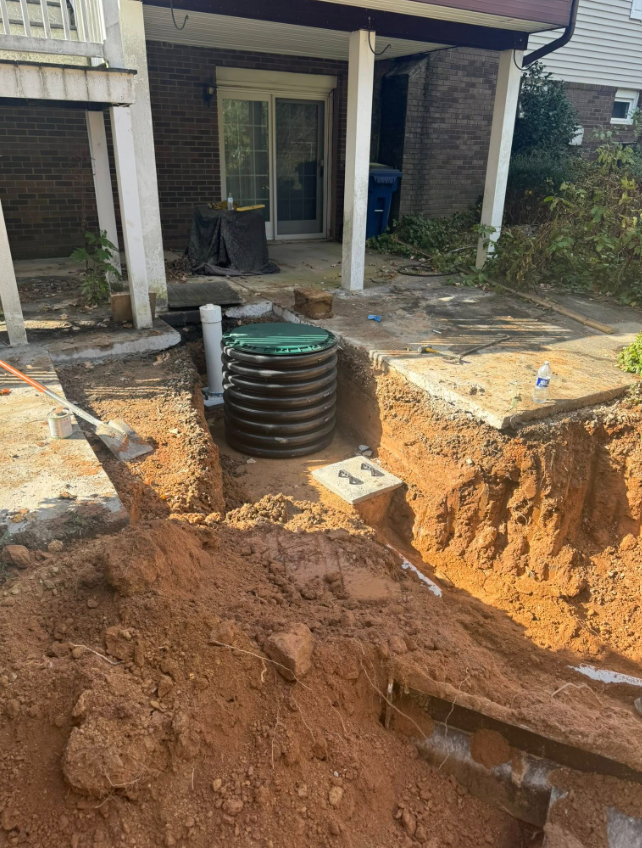Understanding Different Types of Septic Systems
When it comes to managing household wastewater safely and effectively, choosing the right septic system for your property is critical. Colson’s Septic Services—serving Carroll, Howard, Frederick, Baltimore, and Montgomery Counties in Maryland—understands how crucial it is to match system type to soil conditions, water tables, and maintenance capabilities. Here’s a deep dive into three common systems: conventional, mound, and aerobic (ATU).
- Conventional Septic Systems
How They Work
A conventional septic system consists of two primary components: a septic tank and a drain field (leach field). Wastewater flows into the tank, where solids settle and are broken down by anaerobic bacteria; the liquid effluent then percolates into the soil for further natural filtration.
Pros
- Lowest initial cost and simplest design.
- Silent operation with no mechanical parts.
- Minimal maintenance beyond regular pumping and inspection.
Cons
- Not suitable for soils with poor drainage, high water tables, or shallow bedrock.
- Large drain field needed, limiting available space.
- Risk of contamination if soil cannot filter effectively.
Maintenance
- Pump every 3–5 years to prevent sludge and scum buildup.
- Avoid flushing non-biodegradable and harsh chemicals that disrupt bacterial activity.
- Annual inspections to monitor system health.
- Mound Septic Systems
How They Work
Mound systems are designed for properties with high groundwater, shallow soil, or poor soil percolation. Instead of a buried drain field, a constructed mound of sand and gravel receives effluent pumped from the septic tank into an elevated filtration bed, then disperses treated wastewater into deeper native soil layers.
Pros
- Effective in challenging soil or high-water-table conditions where conventional systems fail.
- Additional filtration through sand offers environmental protection.
Cons
- More costly due to sand, gravel, and engineering requirements.
- Requires more physical space for the mound.
- Pumps and distribution mechanisms add complexity and maintenance.
Maintenance
- Monitor mound surface to prevent erosion or settling; replenish sand if needed.
- Regular check of dosing pumps and distribution lines—failure can cause pooling or clogging.
- Continue with tank pumping and routine inspections.
- Aerobic Treatment Units (ATUs)
How They Work
Aerobic systems inject air into the treatment tank, encouraging oxygen-loving bacteria to break down waste more efficiently. This often involves an aeration chamber, air pump, and sometimes disinfection (e.g., UV, chlorination) before effluent disperses.
Pros
- Produces clean, highly treated effluent, suitable for areas requiring extra protection—small lots, sensitive water bodies, high regulatory zones.
- Compact footprint; works well on tight or less-ideal sites.
Cons
- Higher upfront costs and ongoing operating expenses due to electrical components.
- Mechanically complex—air pumps, aerators, alarms, and disinfection units may fail and need servicing.
- Requires frequent maintenance to ensure reliability and environmental safety.
Maintenance
- Periodic service of air pumps, aeration tanks, and disinfection systems.
- Monitor alarms and mechanical components regularly.
- Maintain septic tank routine pumping and inspections.
Comparative Overview
| System Type | Best For | Cost & Complexity | Maintenance |
| Conventional | Standard soil with good drainage | Lowest & simplest | Pump every 3–5 yrs; minimal |
| Mound | Poor soil, high water table | Higher; engineering-intensive | Pump + pump/dosing checks + mound upkeep |
| Aerobic (ATU) | Sensitive environments or tight sites | Highest; mechanical | Frequent service + tank care |
Why Choose Colson’s Septic Services?
At Colson’s Septic Services, we leverage over 30 years of experience in installing, inspecting, pumping, and repairing systems across Maryland counties. Whether you’re dealing with traditional conventional systems—or need advanced solutions like mound or aerobic setups tailored to tricky soil or regulatory conditions—we’ve got you covered. Our professionals conduct perc tests and site evaluations to recommend the optimal system for your property’s needs.
Final Takeaways
- Conventional systems are cost-effective and simple—ideal for properties with suitable soil and ample space.
- Mound systems offer added filtration and are engineered for challenging environments but require bigger budgets and careful upkeep.
- Aerobic systems (ATUs) deliver superior treatment and compact design—an excellent fit for sensitive or constrained properties—but demand ongoing maintenance and come at a premium.
Selecting the right septic system is a balance of soil, regulation, budget, and maintenance expectations. At Colson’s, we’re dedicated to helping homeowners in Maryland confidently choose and care for the right solution—ensuring reliable wastewater treatment and protecting both property value and the environment.
Do you have any questions or need help with your septic system? Reach out to us today! Colson’s Septic Services is here to support you every step of the way!


